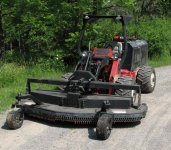ponytug
Super Member
As MossRoad mentioned, the minimum height adjustment is straightforward. If you see something coming that you need a boost for, you can lift the deck. In practice, I suspect you will set it once and forget it.
Once, I tried to inflate my front "pneumatic" wheels, only to discover that they were foam filled, which is why they had never gone soft...
Looking at recent photos, I think that the factory brush cutter design has some recent tweaks in the design that make it better and the lift safer.
Most of the PT brush cutters have, or used to have, exposed blades at the front and rear, so adding chains involves lengthening the deck fore/aft. Having the blades stick out in front is nice in that you can use it to nibble at a largish tree. However, the cutter will throw material a long way forward. I mow in a chainsaw helmet to protect my face from flying debris, and I try to have bystanders several hundred feet away.
I know several of us have thought about adding a push bar 18-24" ahead of the wheels, and about as high to push over heavy brush. Again, in practice, it hasn't been enough of an issue to warrant it for me, as I can push the brush cutter over 8' high tangles of three to four inch diameter poison oak stems. They are tougher than honeysuckle, so you should be OK.
All the best,
Peter
Once, I tried to inflate my front "pneumatic" wheels, only to discover that they were foam filled, which is why they had never gone soft...
Looking at recent photos, I think that the factory brush cutter design has some recent tweaks in the design that make it better and the lift safer.
Most of the PT brush cutters have, or used to have, exposed blades at the front and rear, so adding chains involves lengthening the deck fore/aft. Having the blades stick out in front is nice in that you can use it to nibble at a largish tree. However, the cutter will throw material a long way forward. I mow in a chainsaw helmet to protect my face from flying debris, and I try to have bystanders several hundred feet away.
I know several of us have thought about adding a push bar 18-24" ahead of the wheels, and about as high to push over heavy brush. Again, in practice, it hasn't been enough of an issue to warrant it for me, as I can push the brush cutter over 8' high tangles of three to four inch diameter poison oak stems. They are tougher than honeysuckle, so you should be OK.
All the best,
Peter

